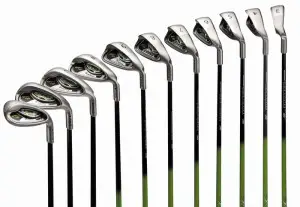Steel Shaft vs Graphite Shaft – Which Should You Choose?

You’re ready to buy your new irons or driver and there’s one question that’s bothering you, just what golf shafts should I choose? Is it steel or graphite shafts? Also, what are the differences between the two, which type of shaft is better for me?

Ping Raptures with Graphite Shaft
It’s one of the many dilemmas that face beginners when they’re ready to buy new clubs, along with what shaft flex they should choose. Golfers who’ve played for years still ask the question “steel or graphite shaft”, when they’re shopping for that new set of irons.
Years ago the general belief was that high to mid handicappers (we reviewed the best irons for mid handicappers here) should use graphite and the lower handicap players should use steel shaft golf clubs. That’s not the case though these days as many professional players have gone down the graphite shaft route. Even Tiger, who was and still is one of the biggest drivers on tour, switched from a steel driver to a graphite driver in the 04 season. Several pros made that decision earlier, putting to bed the feeling of graphite shafts being just for beginners.
However, it all comes down to personal preference and what is right for your swing. Just like any other type of golf equipment you purchase, or clothes you buy, it’s important to buy what suits you. You don’t want to buy skinny jeans if you’re slightly overweight, you should buy something that fits. It’s the same with all your golf equipment.
However, there are some differences between graphite and steel shafts that will help you decide which type of shaft is best for you.
Key Points to Help you Decide
- Clubs with steel shafts are generally less expensive when compared to graphite. If you’re stuck between graphite and steel for a set of clubs you like, the steel clubs will cost less.
- The steel shafts used to be regarded as the stronger and more durable of the two shafts however, it’s not necessarily the case anymore. Quality steel shafts will last just as long as graphite, and vice versa, as long as you take care of them that is.
- If you hate the vibration you get from your steel shafted clubs, graphite clubs will produce fewer vibrations on any miss-hit shots. On the other hand, if you like instant feedback on any miss-hit shots then steel is the way to go.
- Perhaps the most important point to consider in the graphite vs steel shafts debate is the fact that graphite shafts are lighter than steel shafts. A graphite club has been proven to produce an extra 2-4mph of club speed in your swing. That 2-4mph increase in clubhead speed translates in to 6-12 extra yards! It’s little wonder Tiger and co. decided to switched to graphite shaft drivers all those years ago.
So what does it all mean?
I guess you’d love to grab extra yards out of your clubs, everyone does. In that case, graphite shafts over steel should be your choice. BUT, that’s not necessarily the case. Let me explain…
As I mentioned before, many pro players choose graphite over steel shafts, at least that’s the case with their woods and driver. Steel still plays a major role in the professionals and low handicappers game, with steel iron shafts the shaft of choice for most.
Steel irons shafts are often the shaft of choice as most low handicappers and pro’s do not need the extra swing speed boost you get when using graphite shafts. Golfers that play with steel shafts often do so because they like to have the feel of the heavier weight, which gives the feeling of more control. Immediate feedback on miss-hit shots is also another feature of steel shafts that many lower handicap players prefer over graphite.
Which should I choose then – Graphite or Steel Shafts?
If your only aim is to get extra distance, then graphite should be the shaft of choice. However, if you already have a quick swing, and you enjoy the feel of control the heavier weight gives you, then steel should be the shaft you go with.
In addition, if you suffer from any physical problems or aren’t as physically strong as you once were, then you should also go with graphite shafts.
[poll id=”2″]




